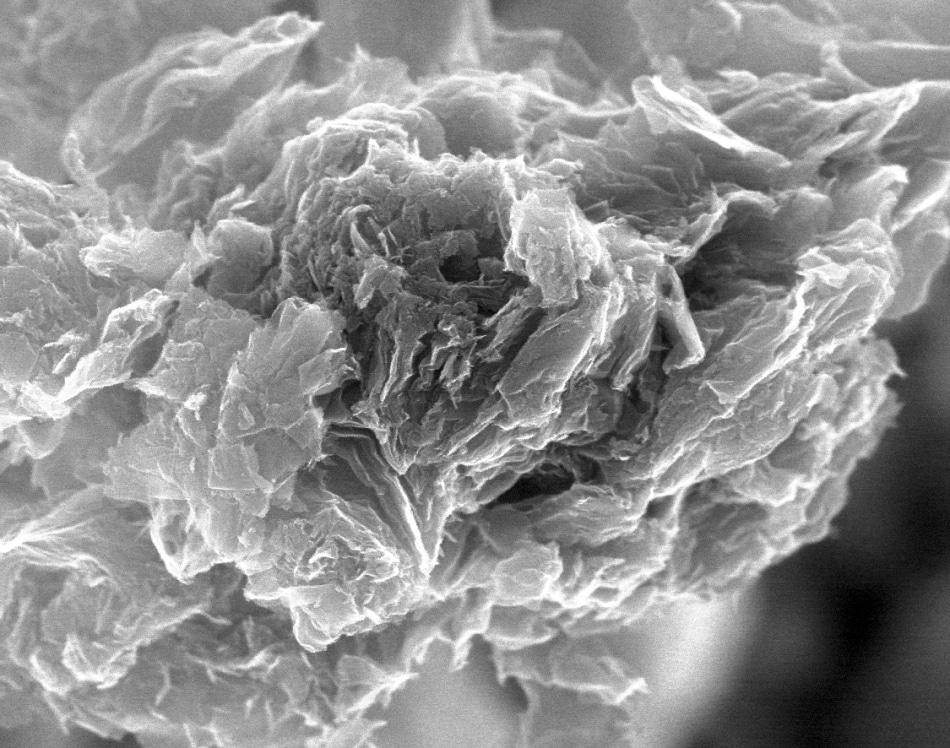Jan 20 2017
 C-seal F, a source used to synthesize oxidatively modified carbon, is seen magnified 20 times by a scanning electron microscope. The material is highly effective at removing radionuclides from water, according to researchers at Rice University and Kazan Federal University. (Credit: Kazan Federal University)
C-seal F, a source used to synthesize oxidatively modified carbon, is seen magnified 20 times by a scanning electron microscope. The material is highly effective at removing radionuclides from water, according to researchers at Rice University and Kazan Federal University. (Credit: Kazan Federal University)
A team of scientists from Kazan Federal University in Russia and Rice University have found a method to extract radioactivity from water. This discovery could help to purify the hundreds of millions of gallons of radioactive water stored after the Fukushima nuclear plant disaster.
They stated that their oxidatively modified carbon (OMC) material is cheap and highly effective at absorbing radioactive metal cations such as strontium and cesium, toxic elements that were released into the environment when the Fukushima nuclear plant melted down after an earthquake and tsunami hit in March 2011.
Rice chemist James Tour, who led the project with Ayrat Dimiev, a former postdoctoral researcher in his lab and now a research professor at Kazan Federal University, stated that the OMC material can easily trap common radioactive elements that enter waterways during oil extraction, such as thorium, radium, and uranium.
According to Tour, the material uses the porous nature of two specific types of carbon. One is a cheap, coke-derived powder called C-seal F, which is already being used as an additive to drilling fluids in the oil industry. The other, shungite, is a naturally occurring, carbon-heavy mineral found mainly in Russia.
The study results appear this month in Carbon.
Tour and scientists at Lomonosov Moscow State University had previously demonstrated a method that used graphene oxide as a sorbent to separate radionuclides from water, as reported late last year in Solvent Extraction and Ion Exchange, however, the new study suggests that OMC is easier and less expensive to process.
Treating the existing carbon particles using oxidizing chemicals increased their surface areas and decorated them with the required oxygen molecules to absorb the toxic metals. The particles varied between 10 and 80 μm in width.
While graphene oxide was better at removing strontium, Tour said, the two types of OMC excelled at removing cesium, which he said has been the hardest element to extract from water stored at Fukushima. The OMC was also less expensive and much easier to synthesize and to use in a traditional filtration system, he said.
We know we can use graphene oxide to trap the light radioactive elements of relevance to the Fukushima cleanup, namely cesium and strontium. But in the second study, we learned we can move from graphene oxide, which remains more expensive and harder to make, to really cheap oxidized coke and related carbons to trap these elements.
James Tour, Chemist, Rice University
He stated that while other materials used for remediation of radioactive waste have to be stored with the waste they acquire, carbon offers a distinct advantage.
“Carbon that has captured the elements can be burned in a nuclear incinerator, leaving only a very small amount of radioactive ash that’s much easier to store,” Tour said.
“Just passing contaminated water through OMC filters will extract the radioactive elements and permit safe discharge to the ocean,” he said. “This could be a major advance for the cleanup effort at Fukushima.”
The two types of OMC particles – from coke-derived carbon and from shungite — appear as balls of crumpled paper, or roses with highly irregular petals. The scientists tested them by mingling the sorbents with contaminated water as well as through column filtration, a traditional process where fluid is pumped or pulled by gravity through a filter to extract contaminants.
In the experiment, the labs dispersed nonradioactive isotopes of cesium and strontium in spring water, added OMC and mixed for two hours. After separating the sorbent, they measured the particles that remained in the water.
OMC1 (from coke) proved to be best extracting both strontium and cesium from contaminated water, getting significantly better while the sorbent was increased. They reported that about 83% of cesium and 68% of strontium from 100 ml of water were removed with a maximum 800 mg of OMC1.
OMC2 (from shungite) in the similar concentrations adsorbed 70% of cesium and 47% of strontium.
The scientists were amazed to see that plain shungite particles removed almost as much cesium as its oxidized counterpart.
Interestingly, plain shungite was used by local people for water purification from ancient times. But we have increased its efficiency many times, as well as revealed the factors behind its effectiveness.
Ayrat Dimiey, Research Professor, Kazan Federal University
In column filtration tests that involved 1,400 ml of contaminated water to flow through an OMC filter in 100-ml amounts, the filter extracted about 93% of cesium and 92% of strontium in a single pass. The scientists were able to contain and separate contaminants captured in the filter material.
Co-authors of the paper are Bulat Gareev, Vadim Nekljudov, Artur Khannanov and Airat Kiiamov, all of Kazan Federal University. Tour is the T.T. and W.F. Chao Chair in Chemistry as well as a professor of computer science and of materials science and nanoengineering at Rice. The Russian Government Program of Competitive Growth of Kazan Federal University supported the research.